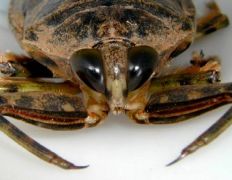
Giant Water Bug Toe Biter: A Detailed Look into the Aquatic Menace
The giant water bug, also known as the toe biter, is a creature that has sparked both fear and fascination among those who encounter it. With its menacing appearance and reputation for biting, this aquatic insect has become a subject of intrigue. In this article, we will delve into the various aspects of the giant water bug toe biter, providing you with a comprehensive understanding of this intriguing creature.
Appearance and Size

The giant water bug, scientifically known as Belostoma, is a large insect belonging to the Hemiptera order. It is characterized by its elongated, flattened body, which can grow up to 5 inches in length. Its coloration ranges from a dark brown to a metallic green, making it well-camouflaged in its aquatic environment. The most distinctive feature of this bug is its large, prominent eyes, which allow it to have a wide field of vision and detect prey from a distance.
Habitat and Distribution

The giant water bug is primarily found in freshwater habitats, such as ponds, lakes, and slow-moving rivers. It is native to tropical and subtropical regions, with a wide distribution across Asia, Africa, and the Americas. This insect thrives in warm, humid climates, where it can be found basking on the surface of the water or lurking beneath aquatic vegetation.
Diet and Feeding Habits

The giant water bug toe biter is a voracious predator, feeding on a variety of aquatic organisms. Its diet includes insects, crustaceans, and even small fish. This bug has a unique feeding mechanism that involves injecting its prey with a toxic cocktail of enzymes and digestive juices. These enzymes break down the prey’s tissues, allowing the bug to consume the liquid contents. This method of feeding is known as predigestion, and it is a characteristic feature of the Hemiptera order.
Reproduction and Life Cycle
The giant water bug toe biter has a fascinating reproductive process. The female lays her eggs in clusters, attaching them to aquatic vegetation or submerged objects. Once the eggs hatch, the larvae emerge and begin their life cycle. The larvae are known as naiads and resemble miniature versions of the adult bug. They undergo several molts as they grow, eventually reaching maturity. The adult bugs have a lifespan of approximately one to two years.
The Bite: Fact or Fiction?
One of the most notorious aspects of the giant water bug toe biter is its reputation for biting humans. While it is true that this insect can bite, it is not as aggressive as commonly believed. The bite is usually a defensive mechanism, occurring when the bug feels threatened or disturbed. The bite can be painful, but it is not venomous, and the wound typically heals quickly. In most cases, the bug will release its grip once the threat has passed.
Conservation Status
The giant water bug toe biter is not currently listed as an endangered species. However, its populations may be declining in some areas due to habitat loss and pollution. Efforts are being made to protect these insects and their habitats, ensuring their survival for future generations.
Conclusion
The giant water bug toe biter is a fascinating creature that has captured the imagination of many. Its unique appearance, feeding habits, and life cycle make it a subject of interest for scientists and enthusiasts alike. While its bite can be painful, it is important to remember that this insect is primarily a predator of other aquatic organisms. By understanding the giant water bug toe biter, we can appreciate its role in the ecosystem and the importance of preserving its natural habitat.
| Characteristics | Description |
|---|---|
| Size | Up to 5 inches in length |
| Coloration | Dark brown to metallic green |
| Feeding Habit | Predator of insects, crustaceans, and small fish |
| Reproduction | Female lays eggs in clusters, attaching them to aquatic vegetation |
| Bite | Painful but not venomous, usually a defensive mechanism |






